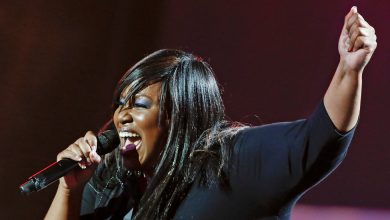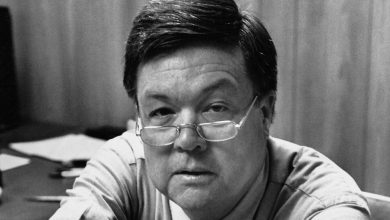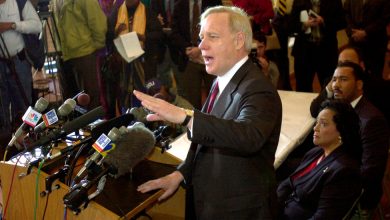‘How to Dance in Ohio’: A Story About Autism and Connection

To get to Amigo Family Counseling, I walked down beige hallways on the first floor of a building in a ho-hum Columbus, Ohio, office park a short walk from a Bob Evans restaurant.
The center’s clinical director, Dr. Emilio Amigo, waved at me once I got inside. Behind a closed door I heard the voices of his clients — autistic young adults from mostly working- and middle-class central Ohio families — boisterously chatting about their Friday night plans.
I was there to talk about “How to Dance in Ohio,” a new Broadway musical that features Dr. Amigo and seven of his autistic clients as characters. The show — pop in score and sensibility — is based on Alexandra Shiva’s 2015 documentary, which follows Dr. Amigo and many more of his clients as they navigate life and eagerly, but anxiously, prepare for a spring formal. (The musical is in previews at the Belasco Theater in Manhattan, where it is scheduled to open on Dec. 10. The documentary is on Max.)
In a room filled with board games and framed illustrations of rainbow-bright robots, I met Tommy Van Atta. I asked him to tell me what it was like to be in the documentary and now be a character in a musical adaptation. Van Atta, 28, who has the frame of a linebacker, paused for a few seconds, then spoke softly.
“I’ve never really been into musicals, but I’ve also not had much experience with musicals,” he said. “It was just another day.”
That’s the most honest answer I’ve heard from anyone I’ve ever interviewed who was attached to a Broadway show — an example, Dr. Amigo later told me, of how many autistic people “don’t have a lot of the filters, that extra stuff that protects and hides and makes us not realize the truth.”
I met Jessica Sullivan, 33, one of three women the documentary features prominently. She told me at first she thought the musical would be about her, but now she knows “it’s all about all my friends and how we struggle and how we grow together.”
I also met Drew Swanson, 27, who was dressed in a Michael Jackson T-shirt and gym shorts. He didn’t smile, but his words were thoroughly joyful.
“If anybody would have told me that in a thousand years or maybe even a millennium that there would ever be a musical, I would say get out of here, I don’t even know what you’re on,” he said. “I’m excited that it’s actually a musical, and I’m glad that my name is part of it.”
Back at the Belasco in New York, I met up with the show’s creators, Jacob Yandura (score) and Rebekah Greer Melocik (book and lyrics); its director, Sammi Cannold; and its choreographer, Mayte Natalio.
Yandura and Melocik were inspired to adapt the documentary because as specific as the film is about one community of neurodiverse people, the story it tells is a universal one. After all, getting ready for a dance — asking someone out, being fitted for formal wear — is exciting and tense for any young adult.
The film “completely sang to me,” said Yandura, “because of all the ideas of human connection, and that’s so musical to me.”
In a Broadway first, openly autistic actors are playing the autistic characters, in this case seven. All those actors are making their Broadway debuts. (Non-autistic actors portray other people, including Dr. Amigo, played by Caesar Samayoa.) Ashley Wool, who plays Jessica, hopes the casting puts to rest a misconception about autistic actors: That if there are any, they must be less talented or expressive.
“It’s not like we’re trying to say any autistic person can be on Broadway,” Wool said in a video call. “We’re saying that autism disclosure should not be an automatic deterrent for people who want to cast us.”
The idea for “How to Dance in Ohio” started around 2017, when Shiva signed off on Yandura and Melocik’s idea to adapt the documentary and the composers befriended Ben Holtzman, then the assistant to Hal Prince, the longtime Broadway producer and director. One of Prince’s grandchildren, Lucy Chaplin, is autistic, and, according to Shiva, was the inspiration for the documentary because she was an example of a young person who was “growing up and aging out of a lot of their supports.” Chaplin, now 25, was one reason Prince decided to direct the stage production, which he did for two years as the show developed, according to Yandura. Melocik and Yandura said Prince’s last notes came just days before he died in 2019.
Melocik and Yandura have relationships to the show that are personal too. Both are originally from Northeast Ohio. Melocik is neurodivergent — she has Tourette’s syndrome — and Yandura’s sister is autistic. Both are making their Broadway debuts.
Cannold took over as director right before the pandemic hit. She had a head start: Holtzman, now a producer of the show, saved audio recordings of meetings between Prince and the show’s creators, as well as copies of Prince’s scribbled-on script.
Cannold told me the most intriguing message Prince left were the words “Our Town” notating a scene in which the autistic characters prepare for their day. It was a reference, Cannold thinks, to David Cromer’s 2009 Off Broadway revival of the Thornton Wilder play in which the smell of sizzling bacon tantalized the audience.
“I think what he meant was that the sensory experience of an autistic individual smelling breakfast is part of the way that characters in the script would go about their daily routine,” Cannold said.
Working with autistic performers has its rewards, Cannold noted: They often want information imparted efficiently, rather than being asked to figure out motivation or blocking.
“With other actors, I’ll come in with a plan, and they’ll be like, ‘But I was thinking I would do all these things,’” Cannold said. Autistic actors, she added, “take the information, and that’s what we see.”
Or as Melocik put it: Autistic people are “the perfect people to be actors because they’ve been scripted their entire lives.” The stage, she added, “is a safe, predictable place to play.”
Natalio, the choreographer, said that when she’s asked about the challenges of working with autistic individuals, she answers with a plus.
“Once they learn things, it’s like nothing else,” she said. “Once it’s in their bodies — music and movement — they study it, and they learn it, and it’s incredible how consistent they are, more than other casts that I’ve been involved with.”
Dramatically, “How to Dance in Ohio” mostly sticks to the events in the documentary, but like most adaptations, it tweaks reality and invents stakes. One of Dr. Amigo’s three children, Ashley (played by Cristina Sastre), has a bigger role than she did in the documentary. (In real life, she runs an acting program at the clinic.) Melocik made up a newspaper article that sparks a second-act conflict. Some characters are amalgamations of real documentary subjects.
In one scene, Dr. Amigo flirts with a woman, leaving the impression that the real doctor is straight, which he is not. Yandura, who is gay, said the switch was a matter of timing, not erasure. It was during the making of the musical that Dr. Amigo, who said he grew up in a “very traditional Christian family,” came out, divorced his wife of over 20 years and last year married his husband, Doug Smith.
Amigo said he never shared his sexual identity with his clients until he realized they might meet Smith at Syracuse Stage in central New York, where “How to Dance in Ohio” premiered last year to mostly positive reviews. So he came out to his clients in a “session focused on owning who you are.”
If there is one thing Dr. Amigo is not thrilled with, it’s how outsiders are characterizing the musical as being about autistic people who put on a dance. That is not something his clients would do on their own, he said, without it being a part of a therapeutic treatment.
“A whole treatment team helped and supported these individuals over the years to get the nerve to do that,” he said.
As for the rest of the show, it “does a good job,” he said.
According to almost everyone I spoke with for this article, the theater industry has work to do to better embrace potential theatergoers with autism. A bright spot is the Theater Development Fund’s autism friendly performances, which started with Disney’s “The Lion King” in 2011 and has continued for such hits like “Hadestown.” Next up: A special 9 a.m. performance of “Christmas Spectacular Starring the Radio City Rockettes” on Nov. 19, and a performance of “How to Dance in Ohio” on Jan. 28.
Openly autistic actors performing onstage is not common, but it’s also not new. In 2017 at Syracuse Stage, the autistic actor Mickey Rowe played the autistic teenager at the center of the Tony Award-winning play “The Curious Incident of the Dog in the Night-Time.”
But that was exception. Of the people I spoke with, the best grade anyone gave Broadway when it came to autism and accessibility was a D+.
“How to Dance in Ohio” is aiming for an A. The production hired Ava Xiao-Lin Rigelhaupt, who is on the autism spectrum, as its autistic creative consultant to make sure the script is authentic about autism and that rehearsal rooms are accessible, among other concerns. The production is working on several front-of-house accessibility efforts, including cool-down spaces. And while the production is sensory friendly, the T.D.F. performance in January will offer further accommodations, like keeping on the house lights during the performance.
Wool said she was impressed when she and the cast members were asked to fill out accessibility-needs surveys.
“Nobody’s ever asked me that before,” Wool recalled. “What makes you uncomfortable? We’re not taught to think about that as actors. But that’s what’s going to nudge the needle in a better direction for Broadway.”
For actors who are not out about being autistic, the musical could be more than an opportunity to perform on Broadway, Wool said. It could also, finally, be a big break.
“The irony is not lost on me that parts of me that I was taught to suppress ended up being the thing that led to my Broadway debut,” she said.




